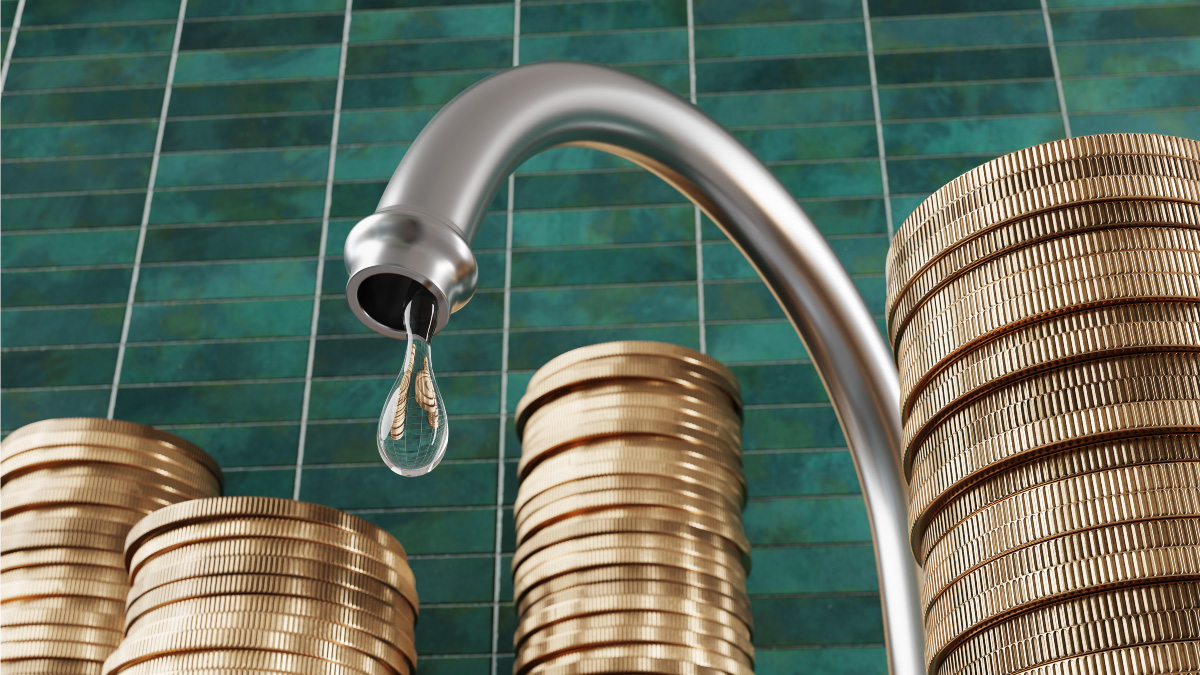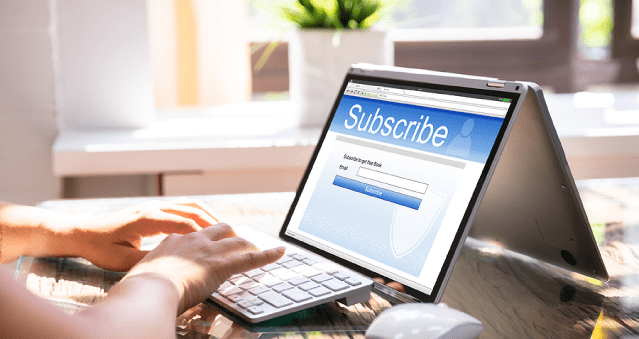Like a dripping faucet, revenue leakage – which may initially start as a slow financial drip – over time will drain your organization’s profitability. Unlike customer churn, revenue leakage is when a company loses money, that in many cases could have been preventable. Put another way, revenue leakage is earned revenue – that has simply vanished.
A couple of questions come to mind… First, is all revenue leakage preventable? The short answer to this question is no. However, there are strategies you can put in place that will minimize revenue leakage. Second… Do all industries encounter revenue leakage? For the most part, yes they do. Unfortunately, revenue leakage is more prevalent in industries that require complex billing systems, like telecom, software as a service (SaaS), finance, and logistics. And finally… What are the reasons organizations encounter revenue leakage? This question requires a more detailed answer as there are numerous reasons revenue leakage occurs. Read on for the most common causes of revenue leakage.
Why Revenue Leakage Happens
Often due to processing issues, errors, missed opportunities, or internal inefficiencies, the most common reasons for revenue leakage falls into the following categories:
Human Errors
Mistakes in billing or invoicing are the most frequent causes of revenue leakage. These errors are often compounded for companies that rely heavily on manual data entry, such as the use of spreadsheets.
Billing and Invoicing
While touched on above, this operational issue requires a deeper explanation. Inaccurate billing occurs when products or services are delivered but not properly billed. Additionally, delayed invoicing often results in delinquent payments or even non-payment. And finally, revenue leakage occurs when services are provided but never invoiced, particularly for add-ons, overages, or time-based services.
Payment Collections
Taking the above one step further, lack of dunning processes results in inefficiencies that may result in uncollected receivables.
Product/Services Pricing
When it comes to pricing, pricing misalignment results in two outcomes – undercharging, which reduces revenue and profitability and overcharging, which potentially can lead to customer dissatisfaction and churn.
Sales and Contracts
This category can be summed up in three sub-categories – discounts, contract non-compliance, and scope creep. Discount mismanagement occurs when sales teams offer unauthorized discounts or fail to properly apply terms. Contract non-compliance has two sources of revenue leakage – customers not adhering to the agreed-upon contract terms or the business not enforcing the terms. Scope creep refers to the company providing more than what was contractually agreed upon and not charging for the extras.
Fraudulent Activities
Fraud can happen both internally and externally like unauthorized discounts, falsified refunds, or embezzlement. This type of revenue leakage often goes unnoticed for extended periods, resulting in long-term financial loss.
Technology Gaps
Obsolete software can’t handle today’s pricing models or customer demands, resulting in revenue leakage. Further to the point, systems like customer relationship management (CRM), enterprise resource planning (ERP), and billing require real-time data synchronization to help ensure accurate and complete data to identify revenue gaps.
Analytics, Reporting, and Audits
Analytics and reporting are important tools when it comes to identifying where and how revenue leakage is occurring. Similarly, regular auditing is required to ensure billing and revenue processes are timely and accurate, and that revenue recognition is error free.
Additional causes of revenue leakage can be:
- Poor inventory management resulting in stockouts or overstock
- Inefficient customer retention strategies, resulting in high churn rates
- Unclear or inefficient communication between departments
- Failure to capitalize on upselling and cross-selling opportunities
- Non-compliance with regulations, leading to fines or penalties
- Credits, refunds, or pricing adjustment errors
- Tax miscalculations like applying incorrect tax rates
- Poor subscription management, such as not billing for auto-renewals
How Revenue Leakage Affects Revenue and Cash Flow
Revenue leakage can cause substantial damage to a company’s profitability and cash flow. When revenue “leaks”, you’re not collecting all the money you should – regardless of the cause. Say that sales are at a record high with revenue flowing in like never before. Revenue leakage keeps you from capturing the full financial value of the products/services sold, (cutting directly into profitability).
Often revenue leakage occurs due to inefficient systems or manual processes. While fixing these issues will plug the “leak”, they typically take time to resolve. This leaves you with increased operational costs and a reduction in overall margin. When this happens, revenue is typically under-reported or lost, making your top line appear less than it really is. Additionally, expenses typically stay the same (or even increase), and with less revenue to offset expenses, net profit shows a decline.
Simply put, cash flow is the movement of money in and out of the business. The effect revenue leakage has on cash flow plays out in a few ways.
- Revenue leakage means less money coming into your business and ultimately less cash on hand.
- Errors or disputes resulting from incorrect billing can delay payments, slowing the inflow of cash.
- When less cash is available, it becomes harder to invest in business growth, cover operating expenses, or even pay staff.
Let’s use an illustration to drive home the effects of revenue leakage on cash flow. Say that your business sold $50,000 worth of software in a month. But due to revenue leakage $5,000 wasn’t invoiced properly, $2,500 was underbilled, and $4,000 remains unpaid due to invoice disputes. This means that even though your financial reports indicate you earned $50,000, you’ll only receive $38,500 due to revenue leakage. That’s $11,500 missing from your expected cash flow!
What it Takes to Detect, Diagnose, and Minimize Revenue Leakage
Now that we’ve covered the primary sources of revenue leakage, how can you detect and diagnose revenue leakage?
Key to detecting revenue leakage lies in tools to aid in revenue leakage detection, revenue leakage detection strategies, best practices to minimize revenue leakage, and performance metrics to monitor and analyze “leaks”.
Revenue Leakage Detection Tools
Detecting revenue leakage requires a combination of tools to help you monitor processes, analyze data, and enforce controls across your revenue cycle. Here’s a breakdown of the tools you should consider.
- Revenue leakage detection tools to analyze sales activities, forecasts, and pipeline health to uncover gaps between expected and actual revenue, and identify missed opportunities, poor conversion rates, or pipeline risks.
- Subscription billing and revenue recognition tools to automate billing, reduce manual errors, and ensure proper revenue recognition. These tools also help to prevent underbilling, missed renewals, and improper revenue deferral.
- ERP or billing systems that contain revenue management modules to identify discrepancies between bookings, billings, and collections, as well as to provide centralized control over invoicing, accounts receivable, contracts, and regulatory compliance.
- Revenue assurance platforms to track and automate revenue workflows.
- Business intelligence platforms to analyze financial data, customer churn, discounting, trends, and pricing issues to determine where and when revenue leakage is occurring.
- Extract, Transfer, Load (ETL) and data quality tools to integrate and cleanse data from multiple systems such as CRM, Billing, ERP, etc.
- CRM systems with workflow automation to automate renewals, deal approvals, contract lifecycles, and follow-ups to help prevent missed opportunities.
- Robotic Process Automation (RPA) to automate repetitive tasks like billing audits, data reconciliation, and exception reporting, reducing human error and speeding the resolution of revenue-impacting issues.
- Configure Price Quote (CPQ) tools to help enforce pricing rules and discount thresholds, which will decrease margin erosion.
- Contract Lifecycle Management (CLM) to monitor contract terms, renewal clauses, and revenue-impacting obligations, as well as identify missed renewals or misaligned service delivery.
- Artificial intelligence (AI) and machine learning (ML) platforms to automatically detect anomalies in billing, usage, and transaction data.
Revenue Leakage Detection Strategies
What strategies exist for minimizing revenue leakage? Simply follow these four steps:
- Data auditing and reconciliation: First, cross-check data across CRM, ERP, billing and payment systems to identify anomalies. Second, ensure invoices reflect contractual terms such as pricing, discounts, renewals, etc. And lastly, for subscription/SaaS businesses, verify that customer usage is correctly captured and billed.
- Track key metrics: This will help in identifying gaps that could indicate billing or collection issues, as well as discounts and credits issued. Additionally, high customer churn could be a signal of hidden issues that are impacting revenue.
- Process mapping: Document end-to-end workflows such as sales, billing, and collections to identify where handoffs occur.
- Monitor workflows for root causes of revenue leakage:
- Quote-to-cash (QTC) process steps need to be frequently reviewed to identify errors which typically occur in handoffs.
- Manual overrides such as pricing changes which can result in mistakes.
Best Practices to Minimize Revenue Leakage
Best practices are never a one-and-done initiative. Start with the ones listed below and add to them as you uncover additional best practices that will help in plugging revenue leaks.
- Check for missing or broken integrations between CRM, ERP, and billing systems.
- Scan for missed renewals and price escalations that weren’t applied.
- Implement controls and approval workflows for discounts, pricing, and credits.
- Maintain detailed logs to track who made changes and when.
- Perform internal audits.
- Maintain a single source of truth for contracts and customer data.
- Conduct quarterly revenue leakage reviews.
- Provide ongoing staff training.
Performance Metrics to Monitor and Analyze Revenue Leakage
Optimize revenue streams by tracking and analyzing the following performance metrics:
- Revenue growth rate to assess overall business growth compared to past performance or industry standards.
- Customer lifetime value (CLV) to better understand the long-term value of a customer, which can be used to improve retention strategies and lessen customer acquisition costs.
- Average revenue per user (ARPU) to gain insights into the effectiveness of your pricing strategies and aid in maximizing the revenue per customer.
- Customer acquisition cost (CAC) to determine the efficiency of marketing efforts, and whether you’re acquiring customers cost-effectively relative to their lifetime value.
- The percentage of customers that stopped using your product or service (churn rate), which has a direct effect on revenue streams.
- Net revenue retention (NRR), a critical indicator of revenue growth, it accounts for both customer retention and customer expansion.
- Gross profit margin to determine the efficiency of your operations in generating a profit.
- Sales pipeline value to gain insight into future revenue, which helps in predicting cash flow and identifying gaps in sales efforts.
How Revenue Leakage is Tied to Revenue Recognition, Revenue Management, and RevOps
Revenue leakage intersects three key revenue disciplines and principles – revenue recognition, revenue management, and revenue operations (RevOps).
Revenue Leakage and Revenue Recognition
Both revenue leakage and revenue recognition are tied together to ensure that businesses don’t miss out on revenue, while also ensuring they adhere to proper revenue recognition standards. For instance:
- When businesses correctly recognize revenue and are compliant with accounting principles, they ensure that all earned revenue is captured, helping to reduce revenue leakage
- When revenue leakage occurs such as due to underbilling or invoice errors, it can lead to misrepresentation of the accurate financial picture. This can lead to revenue recognition issues, where businesses either underreport or overreport earnings.
- Tight controls and audits around revenue recognition can help identify revenue leakage points. This includes monitoring contracts, usage metrics, and payment terms.
Revenue Leakage and Revenue Management
The intersection of revenue leakage and revenue management lies in the challenge of identifying, preventing, and minimizing potential revenue losses. When a company experiences revenue leakage, it undermines the very strategies revenue management employs to optimize profitability, including:
- When discounts and pricing errors are not properly controlled, the business stands to lose more revenue than expected, negating the gains from their revenue management efforts.
- Inefficiencies in billing or invoicing can result in customers being undercharged, creating a gap between the revenue forecasted through revenue management and the revenue realized.
Revenue Leakage and RevOps
RevOps is uniquely positioned to identify and fix revenue leakage. The connection between revenue leakage and RevOps helps businesses identify and plug gaps in their revenue-generating processes. Here are key RevOps functions and how they prevent revenue leakage.
- Process Alignment: Ensures smooth handoffs between teams to avoid dropped leads or opportunities.
- Data Visibility: Detects pipeline conversion/subscription renewal anomalies or gaps.
- Technology Integration: Automates workflows and reduces human error in quoting or billing.
- Contract Lifecycle Management: Prevents/lessens revenue leakage due to poor tracking of terms/renewals.
- Pricing & Quoting Governance: Enforces discount controls and pricing compliance.
- Revenue Accrediting: Ensures the proper crediting of revenue to campaigns and sales reps.
Hone in on Billing, Payment Failures, and Accounts Receivable to Lessen Revenue Leakage
In many respects, lessening revenue leakage happens by improving your billing accuracy, reducing payment failures, and improving accounts receivable processes. Let’s look at each of these in turn.
Billing Accuracy
When it comes to billing accuracy, businesses should focus on the following key areas:
Billing Process Automation: This entails utilizing automated billing software to reduce human errors and streamline invoicing processes. When integrated with other systems, such as CRM and ERP, businesses gain consistency in pricing, services, and payments.
Standardizing Pricing and Contracts: Consider these three key elements:
- Standardized pricing models to avoid miscommunication and customer misunderstanding
- Regular review of contracts to ensure that pricing, discounts, and terms are aligned with the offerings provided
- Conduct frequent audits of your pricing structures to ensure that the business isn’t inadvertently undercharging or overcharging customers
Data Accuracy Improvement: Ensure customer information like contact details, payment methods, etc. are accurate and regularly updated to prevent billing errors.
Detailed Invoices: Invoices should clearly display charges, taxes, discounts, and any additional fees to avoid confusion and disputes.
Audits and Reconciliation: Implement a process for regular billing audits to identify discrepancies or missed charges. Adhering to ASC 606 revenue recognition best practices is key.
Potentially Fraudulent Activities: Implement systems to detect fraudulent activities, such as unauthorized billing or account access. Additionally, limit access to billing systems to authorized personnel only.
Customer Dispute Resolution: Create a transparent process for customers to dispute charges and resolve disputes promptly. Also, regularly review and analyze recurring disputes to identify patterns or errors that could be impacting billing accuracy.
Payment Failure Reduction
Reducing payment failures is critical for businesses that rely on recurring revenue. You can minimize payment failures by:
- Offering multiple payment options.
- Implementing automated retry logic when a payment fails.
- Addressing payment declines early in the process.
- Sending payment reminders in advance of payment due dates.
- Notifying customers immediately when a payment fails.
- Offering self-service payment management.
- Leveraging systems or services to detect upcoming card expiration dates and sending customers early notifications.
- Providing flexible billing plans, such as monthly, quarterly, or annually.
- Utilizing a payment gateway that provides fraud protection.
- Using a dunning management system.
Accounts Receivable
Improving accounts receivable is crucial for avoiding revenue leaks, ensuring cash flow stability, and maintaining financial health. Here’s several ways you can streamline the accounts receivable process and reduce revenue leakage.
- Automate invoice generation and distribution
- Standardize payment terms
- Use electronic payment methods
- Implement a credit approval process
- Review accounts receivable aging reports
- Offer discounts for early payments
- Develop and adhere to payment dispute resolution processes
- Outsource collections when needed
- Train employees on accounts receivable best practices
When used in combination, you can improve your accounts receivable process, lessen revenue leakage, and improve cash flow.
Plug Revenue Leaks
Addressing revenue leakage requires a strategic approach that spans detection and diagnosis, while plugging the “leaks” through technology, strategies, and best practices. BillingPlatform is here to help. From order capture and billing operations to cash acceleration and accounting, we automate the entire revenue lifecycle.
With AI-powered efficiency for billing and revenue management, BillingPlatform provides the tools you need to plug revenue leaks across the entire revenue cycle. Our cloud-based, industry-leading billing solution streamlines the entire order management process, automates and optimizes every aspect of the billing cycle, and provides automated collections and real-time payment processing to improve cash flow and reduce manual efforts – enabling you to plug revenue leaks.



